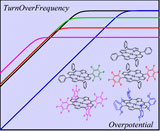Publication
815
J. Phys. Chem. C, 120 (51) 28951–28960, 2016
DOI:10.1021/acs.jpcc.6b09947
|
|
|
|
|
|
 |
Dissection of electronic substituent effects in multielectron-multistep molecular catalysis. Electrochemical CO2-to-CO conversion catalyzed by iron porphyrins |
|
|
|
Iban Azcarate, Cyrille Costentin, Marc Robert, and Jean-Michel Savéant
Laboratoire d’Electrochimie Moléculaire, Unité Mixte de Recherche Université - CNRS No. 7591, Université Paris Diderot, Sorbonne Paris Cité, Bâtiment Lavoisier, 15 rue Jean de Baïf, 75205 Paris Cedex 13, France
Redox pairs of transition metal complexes are often involved in small molecule activation in response to modern energy challenges as well as in other areas of electrocatalysis. Within such a family of molecular electrocatalysts, ligand substitution is a means of varying catalytic efficiency, best gauged through catalytic Tafel plots relating overpotential and turnover frequency. In practice, efficient molecular catalysis involves multielectron–multistep processes. It is in this framework that we discuss through-structure inductive substituent effects. What the best choice is for the reference thermodynamic index, how the global substituent effect may be expressed as a function of this index, and how it may be dissected into individual effects assigned to each of the reaction steps are challenging questions that are addressed and resolved here for the first time. The discussion is illustrated by the effect of successive phenyl perfluoration and of o,o'-methoxy substitution of the FeI/0 tetraphenylporphyrin catalysts of the CO2-to-CO electrochemical conversion. Consequences on the relative position of the catalytic Tafel plots are also examined. This analysis of through-structure electronic effects is a necessary preliminary to the investigation of substituent through-space effects (electrostatic, H-bonding) because, albeit of different nature, they may occur simultaneously. Investigation of these two aspects of substituent effects and of the rules that emerge thereof pave the way to future imaginative design of catalysts for the CO2-to-CO-conversion and also for any other molecular catalytic reaction. |

